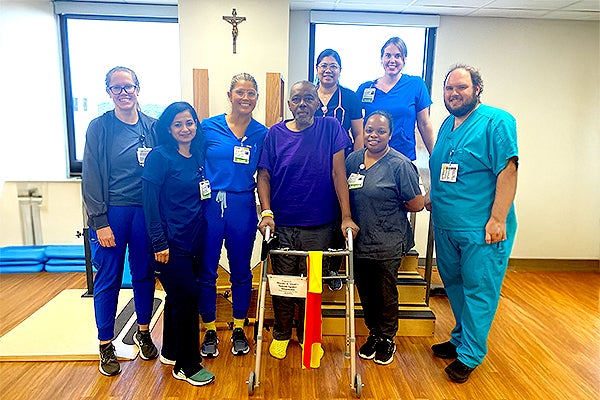Retiree finds support at inpatient rehabilitation facility after a stroke

Ascension St. Vincent’s Southside Inpatient Rehabilitation Facility in Jacksonville, Florida, helps stroke patients recover and regain their strength after a hospitalization.
A story of recovery and resilience after suffering a stroke
When Cranston of Jacksonville, Florida, first noticed something wrong with his left arm, he didn’t think much of it. “I figured I had just slept on it funny,” he recalled.
A few tingles, a little weakness, but nothing to panic over. But as days passed and the sensation didn’t return, he began to grow concerned. After a week with no improvement, he decided to seek help. He visited a local emergency room, where tests revealed something he hadn’t expected: he had suffered a stroke.
For a man who was retired and still very much active with volunteering as a photographer for library groups and spending his time giving back to the community, the diagnosis was both alarming and surreal. He had been independent and self-sufficient his whole life, but was suddenly facing a future that seemed uncertain.
He was transferred to Ascension St. Vincent’s Southside Inpatient Rehabilitation Facility (IRF), a place that would become pivotal to his story of recovery. The facility, recognized by Newsweek as one of America’s Best Physical Rehabilitation Centers, lived up to its reputation in every way that mattered to him.
The IRF focuses on individual situations and needs to meet the functional goals of each patient. During their stay at the facility, they receive up to 15 hours of individualized therapy throughout each week. The unit cares for stroke patients, as well as a variety of diagnoses, including trauma and neurological disorders.
“I didn’t know what to expect going in,” Cranston said. “But from the moment I arrived, I was met with support and encouragement. The team wasn’t just helping me recover, they were challenging me, believing in me, and teaching me to believe in myself again.”
Two members of Cranston’s care team stood out to him during his visit: Marissa and Arina. He described them as incredible motivators to push him to be as independent as he could be.
“They answered my questions and explained things to me,” said Cranston. “They were very patient with me and encouraging.”
Daily routines at the rehab center were structured and purposeful. Tasks that once came effortlessly, like walking or getting dressed, were now tasks he had to learn again. But with every session, Cranston grew stronger. The turning point, he said, came when he was able to gain some of his independence back.
“I am now able to walk around with a walker by myself,” said Cranston. “I can get showered and dressed and am discharging home!”
Though Cranston still has a road to recovery, he is grateful for the care team at the rehabilitation facility for starting him off on the right foot. The supportive environment helped him adjust his outlook on the situation, and he left feeling positive and accomplished.
“Look forward, don’t look back,” Cranston exclaimed. “Accept your new reality and embrace it. Be responsive and ask questions, Try your best!”
Visit our website to learn about the services offered at the award-winning St. Vincent’s Southside Inpatient Rehabilitation Facility.
If you or a loved one is experiencing warning signs of a stroke such as numbness, confusion, trouble speaking, dizziness or loss of balance, every second counts. It's important to call 911 and go to the nearest emergency room right away.
Last updated: May 29, 2025